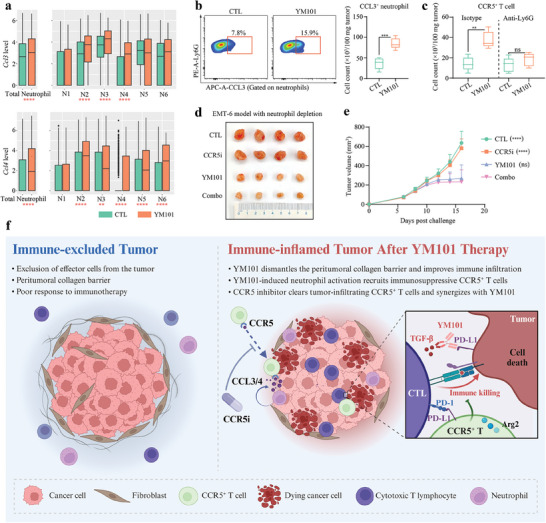Figure 9.

Mechanisms underlying the synergistic effect of CCR5 antagonist and YM101. a) Comparative boxplot analysis depicting the expression levels of Ccl3 and Ccl4 in the total neutrophil population and within specific neutrophil subsets in CTL and YM101‐treated groups. b) Flow cytometry results showing the impact of YM101 treatment on CCL3 expression in neutrophils (n = 5). c) Flow cytometry analysis evaluating the influences of neutrophil depletion on the presence of CCR5+ T cells in the TME following YM101 administration (n = 5). d,e) Establishing the EMT‐6 tumor model to investigate the influence of neutrophil depletion on the synergistic efficacy of CCR5 antagonist and YM101 (n = 8). Statistical analyses were conducted using Student's t‐test. ** p < 0.01, *** p < 0.001, **** p < 0.0001 indicate significant differences. f) Schematic diagram showing the synergistic effect. TGF‐β plays a pivotal role in cancer immune evasion and resistance to immunotherapy by inhibiting the functions of various immune cells and fostering the generation of peritumoral collagen. This physical barrier surrounding the tumor impedes immune cell penetration into the tumor microenvironment (TME), culminating in the formation of immune‐excluded tumors. The anti‐TGF‐β/PD‐L1 bispecific antibody YM101 has demonstrated efficacy in dismantling the peritumoral collagen barrier, facilitating immune infiltration, and partially overcoming immunotherapy resistance. However, YM101 also activates neutrophils within the TME, increasing the expression of CCR5 ligands such as CCL3 and CCL4. This upregulation drives the chemotaxis of immunosuppressive CCR5+ T cells into the TME. These cells, highly expressing immunosuppressive markers like PD‐L1, and Arg2, infiltrate the TME following the collagen barrier disruption, eventually undermining the immunotherapy efficacy. To surmount this challenge, we devised a strategy by combining YM101 with Maraviroc, a CCR5 antagonist. This synergistic approach not only curtailed the accumulation of CCR5+ T cells with immunosuppressive traits but also fine‐tuned the immune response orchestrated by YM101.
